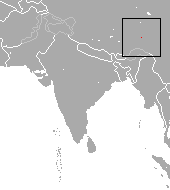| Kozlov's shrew [1] | |
|---|---|
| Scientific classification | |
| Kingdom: | Animalia |
| Phylum: | Chordata |
| Class: | Mammalia |
| Order: | Eulipotyphla |
| Family: | Soricidae |
| Genus: | Sorex |
| Species: | S. kozlovi |
| Binomial name | |
| Sorex kozlovi Stroganov, 1952 | |
 | |
| Kozlov's shrew range | |
Kozlov's shrew (Sorex kozlovi) is a red-toothed shrew found only at the Mekong River, Tibet, China. It is listed as a data deficient species.
